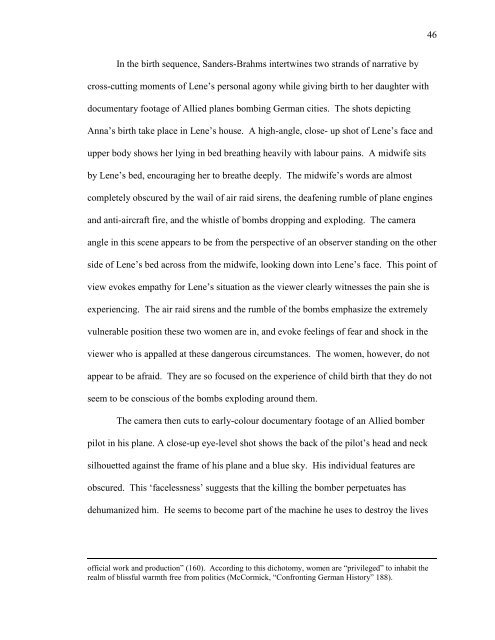'Murderer's House' - University of Victoria
'Murderer's House' - University of Victoria
'Murderer's House' - University of Victoria
Create successful ePaper yourself
Turn your PDF publications into a flip-book with our unique Google optimized e-Paper software.
In the birth sequence, Sanders-Brahms intertwines two strands <strong>of</strong> narrative by<br />
cross-cutting moments <strong>of</strong> Lene‟s personal agony while giving birth to her daughter with<br />
documentary footage <strong>of</strong> Allied planes bombing German cities. The shots depicting<br />
Anna‟s birth take place in Lene‟s house. A high-angle, close- up shot <strong>of</strong> Lene‟s face and<br />
upper body shows her lying in bed breathing heavily with labour pains. A midwife sits<br />
by Lene‟s bed, encouraging her to breathe deeply. The midwife‟s words are almost<br />
completely obscured by the wail <strong>of</strong> air raid sirens, the deafening rumble <strong>of</strong> plane engines<br />
and anti-aircraft fire, and the whistle <strong>of</strong> bombs dropping and exploding. The camera<br />
angle in this scene appears to be from the perspective <strong>of</strong> an observer standing on the other<br />
side <strong>of</strong> Lene‟s bed across from the midwife, looking down into Lene‟s face. This point <strong>of</strong><br />
view evokes empathy for Lene‟s situation as the viewer clearly witnesses the pain she is<br />
experiencing. The air raid sirens and the rumble <strong>of</strong> the bombs emphasize the extremely<br />
vulnerable position these two women are in, and evoke feelings <strong>of</strong> fear and shock in the<br />
viewer who is appalled at these dangerous circumstances. The women, however, do not<br />
appear to be afraid. They are so focused on the experience <strong>of</strong> child birth that they do not<br />
seem to be conscious <strong>of</strong> the bombs exploding around them.<br />
The camera then cuts to early-colour documentary footage <strong>of</strong> an Allied bomber<br />
pilot in his plane. A close-up eye-level shot shows the back <strong>of</strong> the pilot‟s head and neck<br />
silhouetted against the frame <strong>of</strong> his plane and a blue sky. His individual features are<br />
obscured. This „facelessness‟ suggests that the killing the bomber perpetuates has<br />
dehumanized him. He seems to become part <strong>of</strong> the machine he uses to destroy the lives<br />
<strong>of</strong>ficial work and production” (160). According to this dichotomy, women are “privileged” to inhabit the<br />
realm <strong>of</strong> blissful warmth free from politics (McCormick, “Confronting German History” 188).<br />
46

















